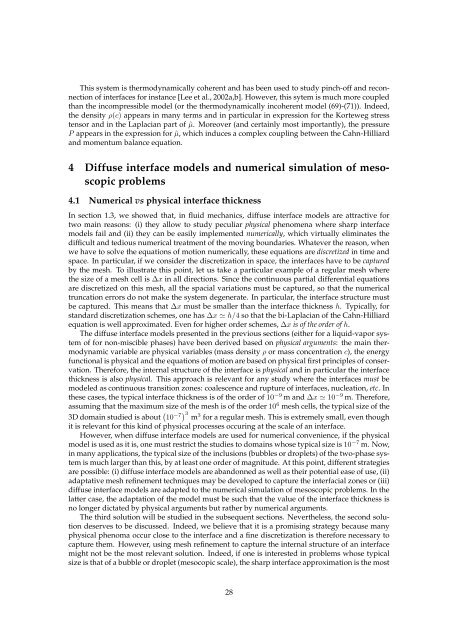Diffuse interface models in fluid mechanics
Diffuse interface models in fluid mechanics
Diffuse interface models in fluid mechanics
Create successful ePaper yourself
Turn your PDF publications into a flip-book with our unique Google optimized e-Paper software.
This system is thermodynamically coherent and has been used to study p<strong>in</strong>ch-off and reconnectionof <strong><strong>in</strong>terface</strong>s for <strong>in</strong>stance [Lee et al., 2002a,b]. However, this sytem is much more coupledthan the <strong>in</strong>compressible model (or the thermodynamically <strong>in</strong>coherent model (69)-(71)). Indeed,the density ρ(c) appears <strong>in</strong> many terms and <strong>in</strong> particular <strong>in</strong> expression for the Korteweg stresstensor and <strong>in</strong> the Laplacian part of ˜µ. Moreover (and certa<strong>in</strong>ly most importantly), the pressureP appears <strong>in</strong> the expression for ˜µ, which <strong>in</strong>duces a complex coupl<strong>in</strong>g between the Cahn-Hilliardand momentum balance equation.4 <strong>Diffuse</strong> <strong><strong>in</strong>terface</strong> <strong>models</strong> and numerical simulation of mesoscopicproblems4.1 Numerical vs physical <strong><strong>in</strong>terface</strong> thicknessIn section 1.3, we showed that, <strong>in</strong> <strong>fluid</strong> <strong>mechanics</strong>, diffuse <strong><strong>in</strong>terface</strong> <strong>models</strong> are attractive fortwo ma<strong>in</strong> reasons: (i) they allow to study peculiar physical phenomena where sharp <strong><strong>in</strong>terface</strong><strong>models</strong> fail and (ii) they can be easily implemented numerically, which virtually elim<strong>in</strong>ates thedifficult and tedious numerical treatment of the mov<strong>in</strong>g boundaries. Whatever the reason, whenwe have to solve the equations of motion numerically, these equations are discretized <strong>in</strong> time andspace. In particular, if we consider the discretization <strong>in</strong> space, the <strong><strong>in</strong>terface</strong>s have to be capturedby the mesh. To illustrate this po<strong>in</strong>t, let us take a particular example of a regular mesh wherethe size of a mesh cell is ∆x <strong>in</strong> all directions. S<strong>in</strong>ce the cont<strong>in</strong>uous partial differential equationsare discretized on this mesh, all the spacial variations must be captured, so that the numericaltruncation errors do not make the system degenerate. In particular, the <strong><strong>in</strong>terface</strong> structure mustbe captured. This means that ∆x must be smaller than the <strong><strong>in</strong>terface</strong> thickness h. Typically, forstandard discretization schemes, one has ∆x ≃ h/4 so that the bi-Laplacian of the Cahn-Hilliardequation is well approximated. Even for higher order schemes, ∆x is of the order of h.The diffuse <strong><strong>in</strong>terface</strong> <strong>models</strong> presented <strong>in</strong> the previous sections (either for a liquid-vapor systemof for non-miscible phases) have been derived based on physical arguments: the ma<strong>in</strong> thermodynamicvariable are physical variables (mass density ρ or mass concentration c), the energyfunctional is physical and the equations of motion are based on physical first pr<strong>in</strong>ciples of conservation.Therefore, the <strong>in</strong>ternal structure of the <strong><strong>in</strong>terface</strong> is physical and <strong>in</strong> particular the <strong><strong>in</strong>terface</strong>thickness is also physical. This approach is relevant for any study where the <strong><strong>in</strong>terface</strong>s must bemodeled as cont<strong>in</strong>uous transition zones: coalescence and rupture of <strong><strong>in</strong>terface</strong>s, nucleation, etc. Inthese cases, the typical <strong><strong>in</strong>terface</strong> thickness is of the order of 10 −9 m and ∆x ≃ 10 −9 m. Therefore,assum<strong>in</strong>g that the maximum size of the mesh is of the order 10 6 mesh cells, the typical size of the3D doma<strong>in</strong> studied is about ( 10 −7) 3m 3 for a regular mesh. This is extremely small, even thoughit is relevant for this k<strong>in</strong>d of physical processes occur<strong>in</strong>g at the scale of an <strong><strong>in</strong>terface</strong>.However, when diffuse <strong><strong>in</strong>terface</strong> <strong>models</strong> are used for numerical convenience, if the physicalmodel is used as it is, one must restrict the studies to doma<strong>in</strong>s whose typical size is 10 −7 m. Now,<strong>in</strong> many applications, the typical size of the <strong>in</strong>clusions (bubbles or droplets) of the two-phase systemis much larger than this, by at least one order of magnitude. At this po<strong>in</strong>t, different strategiesare possible: (i) diffuse <strong><strong>in</strong>terface</strong> <strong>models</strong> are abandonned as well as their potential ease of use, (ii)adaptative mesh ref<strong>in</strong>ement techniques may be developed to capture the <strong>in</strong>terfacial zones or (iii)diffuse <strong><strong>in</strong>terface</strong> <strong>models</strong> are adapted to the numerical simulation of mesoscopic problems. In thelatter case, the adaptation of the model must be such that the value of the <strong><strong>in</strong>terface</strong> thickness isno longer dictated by physical arguments but rather by numerical arguments.The third solution will be studied <strong>in</strong> the subsequent sections. Nevertheless, the second solutiondeserves to be discussed. Indeed, we believe that it is a promis<strong>in</strong>g strategy because manyphysical phenoma occur close to the <strong><strong>in</strong>terface</strong> and a f<strong>in</strong>e discretization is therefore necessary tocapture them. However, us<strong>in</strong>g mesh ref<strong>in</strong>ement to capture the <strong>in</strong>ternal structure of an <strong><strong>in</strong>terface</strong>might not be the most relevant solution. Indeed, if one is <strong>in</strong>terested <strong>in</strong> problems whose typicalsize is that of a bubble or droplet (mesocopic scale), the sharp <strong><strong>in</strong>terface</strong> approximation is the most28











![[Diffusion-Limited Aggregation - A Model for Pattern Formation].](https://img.yumpu.com/52395246/1/190x245/diffusion-limited-aggregation-a-model-for-pattern-formation.jpg?quality=85)




